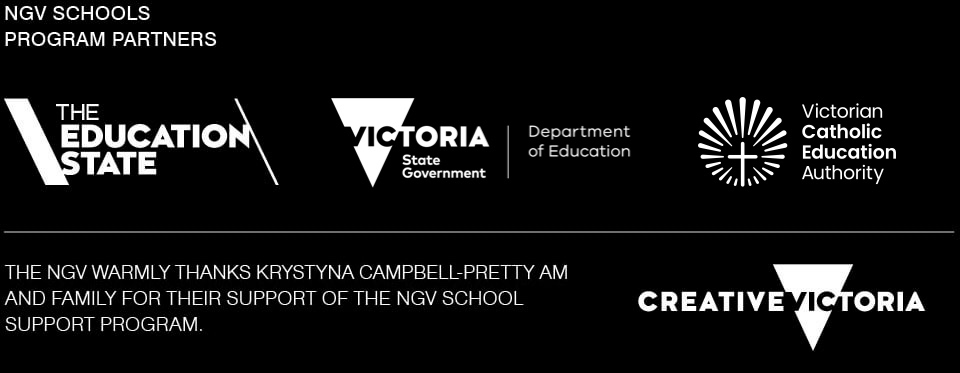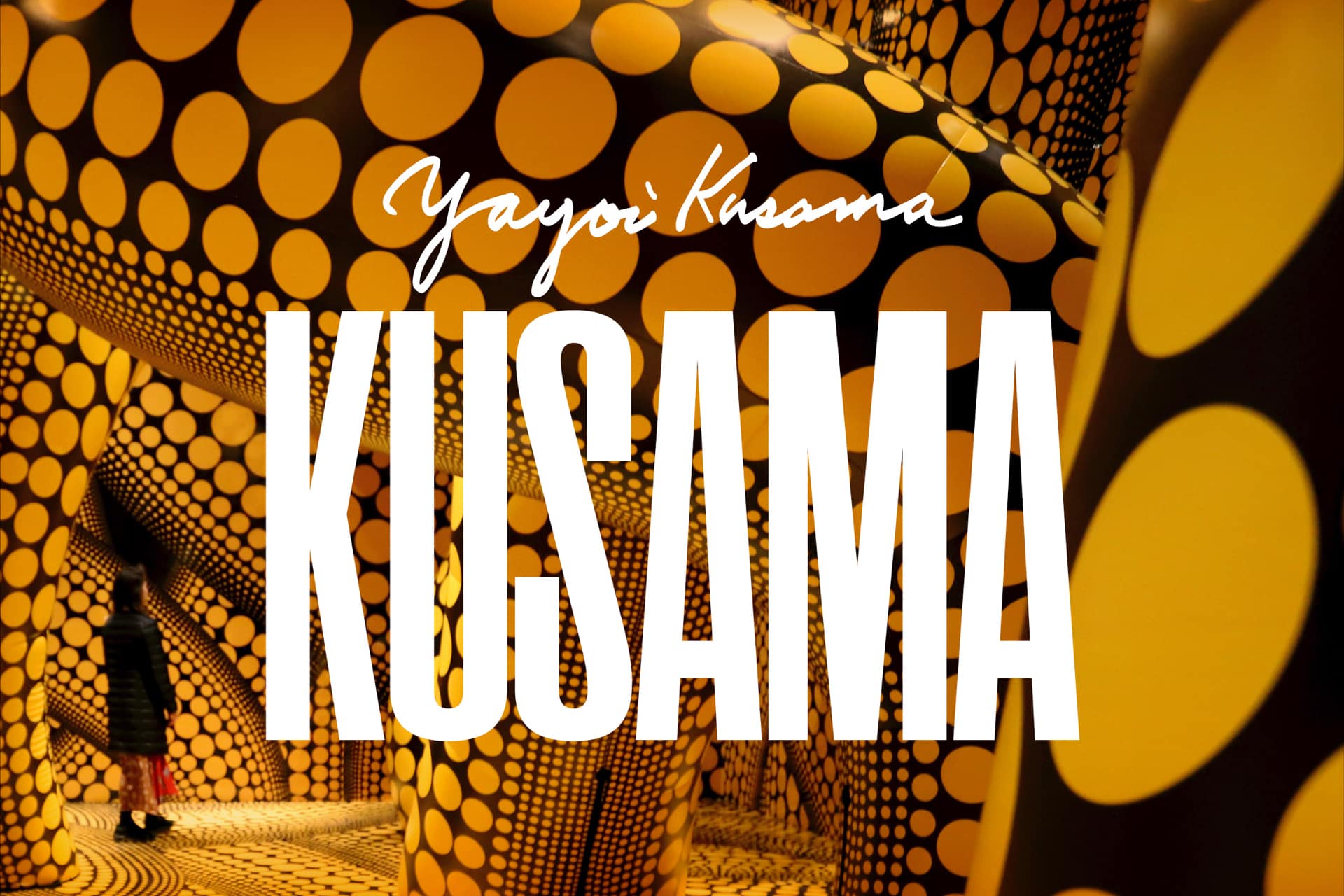Teacher and Student Programs
Born in Japan in 1929, Yayoi Kusama is one of the world’s most important and recognised practitioners working today. Kusama is renowned globally for her singular and idiosyncratic use of pattern, colour and symbols to create immersive, thought-provoking and intensely personal works of art that transcend language and borders. The artist has made indelible contributions to key art movements of the twentieth and twenty-first centuries, including minimalism, pop art, performance and feminist art, and is celebrated today for her instantly recognisable works of art incorporating pumpkin and polka-dot motifs.
Comprising nearly 200 works, the exhibition Yayoi Kusama is the largest ever exhibition of the artist’s work in Australia and one of the most comprehensive retrospectives of the artist ever presented globally. Featuring painting, sculpture, collage, fashion, video and installation, the exhibition reveals the astonishing breadth of Kusama’s multidisciplinary practice.
Yayoi Kusama will be displayed across the entire ground floor of NGV International. Our public spaces will also be transformed by Kusama’s signature polka-dots, extending the sensory experience of Kusama’s work beyond the exhibition galleries to include a site-specific artwork for the NGV’s iconic Waterwall and an installation of enormous balloons that will float playfully over visitors’ heads in NGV International’s Great Hall, titled Dots Obsession. In Federation Court Dancing Pumpkin, a towering 5-metre-tall bronze sculpture newly acquired by the NGV, will make its Australian debut. Conceived by the artist in 2020, Dancing Pumpkin takes Kusama’s iconic motif into new and surprising conceptual terrain and allows audiences to walk under the towering sculpture.
Explore the range of NGV Educator-led programming below, or book a self-guided school visit. Bookings are required for all school groups.
YAYOI KUSAMA SCHOOL VISIT FAQs
How much are exhibition tickets for students?
Tickets for pre-booked groups of primary and secondary school students are $14.00 per student.
Groups receive one complimentary teacher ticket per fifteen students.
Tickets for tertiary students are $35.00.
Do education programs for students include entry to the exhibition?
Our onsite introductory talks for primary, secondary and tertiary students, as well as our focused VCE Art Creative Practice and Art Making and Exhibiting programs, include exhibition entry. Please note that the Dancing Disco Pumpkin Studio Workshop and Discover Kusama Online do not include exhibition entry, but a self-guided visit can be arranged. Additional fees apply.
Where are student introductory talks delivered?
Our introductory talks for primary, secondary and tertiary students, as well as our VCE Art Creative Practice and Art Making and Exhibiting programs, are delivered in a theatre or studio space either before or after a self-guided visit to the exhibition.
What will my students see in the exhibition?
The exhibition features painting, sculpture, collage, fashion, video and installation including immersive rooms.
You can read more about the exhibition themes here.
Some film and archival materials depict nudity and sexual themes. Some artworks relate to themes that may be sensitive for some visitors.
Where possible, we encourage teachers to visit the Gallery prior to visiting with a group to plan a route and to review the works on display.
Are there maps and other access resources available for teachers planning excursions to the exhibition?
Teachers can access an exhibition map displaying useful information about the exhibition and a suggested route for school groups here. Additional information and resources for planning a visit to the exhibition, such as a sensory map, and a Yayoi Kusama exhibition access guide, can be found here.
Is there a free kids’ exhibition, and can school groups access this, too?
Kusama for Kids in the NGV’s dedicated children’s gallery will feature The Obliteration Room, a free interactive installation for children and families. School groups are encouraged to visit and participate in this installation. Please note that access to this area of the exhibition does not require an exhibition ticket.
Will there be timed entry for school groups?
Yes. Exhibition entry time will be organised with you during the booking process.
I plan on bringing a large group of students to see the exhibition. Can we all enter the exhibition together?
To manage crowds in the exhibition, groups of 30 students will be able to enter the exhibition every 30 minutes. The exhibition is split into two sections, Part 1 and Part 2. In some cases, school groups may need to enter Part 2 of the exhibition before entering Part 1.
Supervision of each group of students entering the exhibition is the responsibility of the school. Please consider staff to student ratios when planning your excursion. If you have any concerns, please raise them with our bookings staff when organising your visit.
While waiting to enter the exhibition, we recommend spending time experiencing works on display in the Gallery’s public spaces or our free exhibition space, Kusama for Kids.
Can school groups access all of the installations and immersive experiences?
Please note that some spaces will have capacity limits and wait times for entry which may make it difficult for large groups to access every space in the exhibition. Please refer to the exhibition map on our website with suggested route and highlight moments for student groups.
Will there be lockers for school groups?
Cloakroom facilities are limited. To minimise delays during your visit, please avoid bringing items that need to be cloaked. This includes student backpacks, large bags and umbrellas. Large bags containing first aid kits or essential medical equipment may be carried through the Gallery but must be clearly labelled. Please speak to staff at the Information Desk if you need a label.
Can school groups bring worksheets and pencils into the exhibition?
Due to the immersive and experiential nature of the exhibition, and the fragility of some of the artworks on display, we discourage bringing worksheets and drawing/writing materials into Yayoi Kusama.
Students can complete any written work, including activity sheets, after they have experienced the many different aspects of the exhibition. Teachers can encourage students to take photos and capture videos in the exhibition and refer to them later when completing written tasks and post-excursion reflections.
How long will it take for a school group to see the exhibition?
While exhibition visitation times may vary for each school group, we recommend allowing at least 90 minutes to experience the exhibition, including engagement with works on display in NGV International’s public spaces.
Do teachers need to supervise students at all times in the exhibition?
Yes. Student supervision is the responsibility of the school teachers and other school staff attending the excursion. This applies to all areas in the exhibition, and at all times, including Kusama’s infinity rooms and immersion spaces.
Please note that some of the exhibition’s infinity rooms and immersion spaces have a capacity limit of eight people. In the case of school groups, this includes at least one adult.
Programs for Teachers
Events


